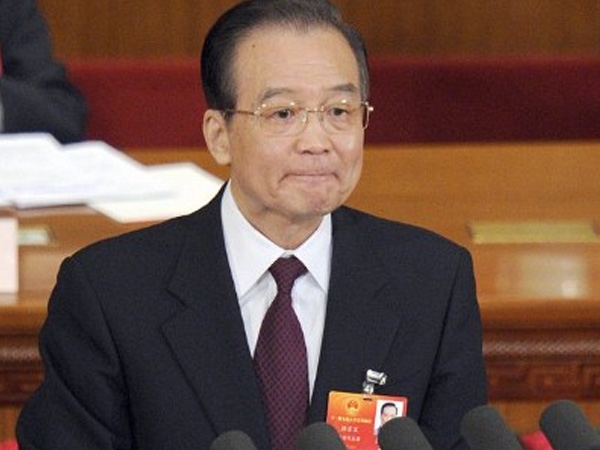

Editorial
Issue No. 559, March 5, 2012
Translated by Zhu Na
Original article: [Chinese]

Source: AFP
This week, the Fifth Plenary Session of the 11th National People’s Congress is being held in Beijing. The conference will approach issues brought up in a work report by Premier Wen Jiabao [delivered after this editorial was published].
The economic growth target for 2012 is one of the most anticipated data points in the report. The EO believes that now is the right time to lower the longstanding annual goal of 8 percent.
Since 2003, China's economy has been in an expansionary phase. During this period, the GDP growth rate reached a high of 13 percent. Even during the global financial crisis in 2008 and 2009, China managed to expand its GDP by more than the mandated 8 percent growth rate target.
The GDP growth target has been set at 8 percent for each of the past eight years. "Maintaining 8 percent" has become the bottom line of economic growth, with anything lower being seen as unacceptable.
In 2011, the country's GDP expanded by 9.2 percent, the same as in 2009, the slowest pace of growth in recent decades.
The reasons for the relatively slow rate of growth in each of these years were different.
The international financial crisis was the main reason behind the dip in 2009. While the economic slowdown in 2011 reflected the impact of the deteriorating international economy, it was also due to government policies of holding inflation in check and pushing ahead with reforms to the structure of the economy.
From the general direction of Central Economic Work Conference laid down at the end of last year, we know that these regulations and control measures will be continued this year.
Accordingly, taking the initiative to reduce the growth target will be a sign of the path that policy makers have decided to take, showing that central government officials have decided to switch speed for time being and will continue to push ahead with transforming the structure of China's economy.
Past experience has shown that when the economy is in fine shape the momentum for reform often weakens.
Adjustments to China’s economic structure have been under debate since the 1997 Asian financial crisis. The current government has also repeatedly explained the necessity and urgency of such changes.
Although there has been some progress, there have been no fundamental changes to the system. In 2008, the goal of restructuring the economy gave way to the priority of rescuing the economy, with a four trillion yuan economic stimulus package injecting an enormous amount of liquidity into the Chinese economy.
Although this stimulus helped boost the economy, most of the planned reforms to the country's economic structure were not completed and on some indicators, the country moved further away from these goals.
China's economy, however, may no longer be able to bear a new round of "stimulus," we should instead allow the economy to slow and seize the opportunity to promote structural reform.
Following the reduction in the GDP growth rate targets of the various provinces and regions, we can see that local governments are all lowering growth rate accordingly. If the central government continues to maintain the 8 percent growth target, this would be a confusing sign to the local leaders.
But we need to be clear, reducing economic growth does not mean a significant slowdown in economic growth.
Based on current domestic economic fundamentals, although export contributions may be reduced, investment is still expected to grow at a rate of more than 20 percent a year.
Industrialization and urbanization is experiencing a rapid growth phase, which will also promote consumption that will help maintain steady growth.
The change in local government strategy will bring forth the opportunity for more projects to be developed, reducing growth to a moderate pace, therefore avoiding a sudden slow down.
Of course, even a gradual economic slowdown means more difficulties for enterprises.
Rapid increases in labor, land and resource costs, as well as the demographic trends all lead to the gradual loss of the demographic dividend, which makes conditions more difficult for businesses.
These difficulties enterprises will face will force a transformation.
We argue that it’s necessary to show more regard for enterprises at the moment, but what the government needs to do is to provide an open and fair business environment and to create benign economic conditions suitable for business growth.
One way to do so is to further remove market barriers and reduce the burden of enterprises through a hefty reduction of taxes.
It should also be noted that in the short term, the economic slowdown will affect the central and local governments' tax revenue, and put pressure on employment, which will require some planning in advance.
The reduction in tax revenues will not, however, affect the implementation of policies of improving people’s welfare.

